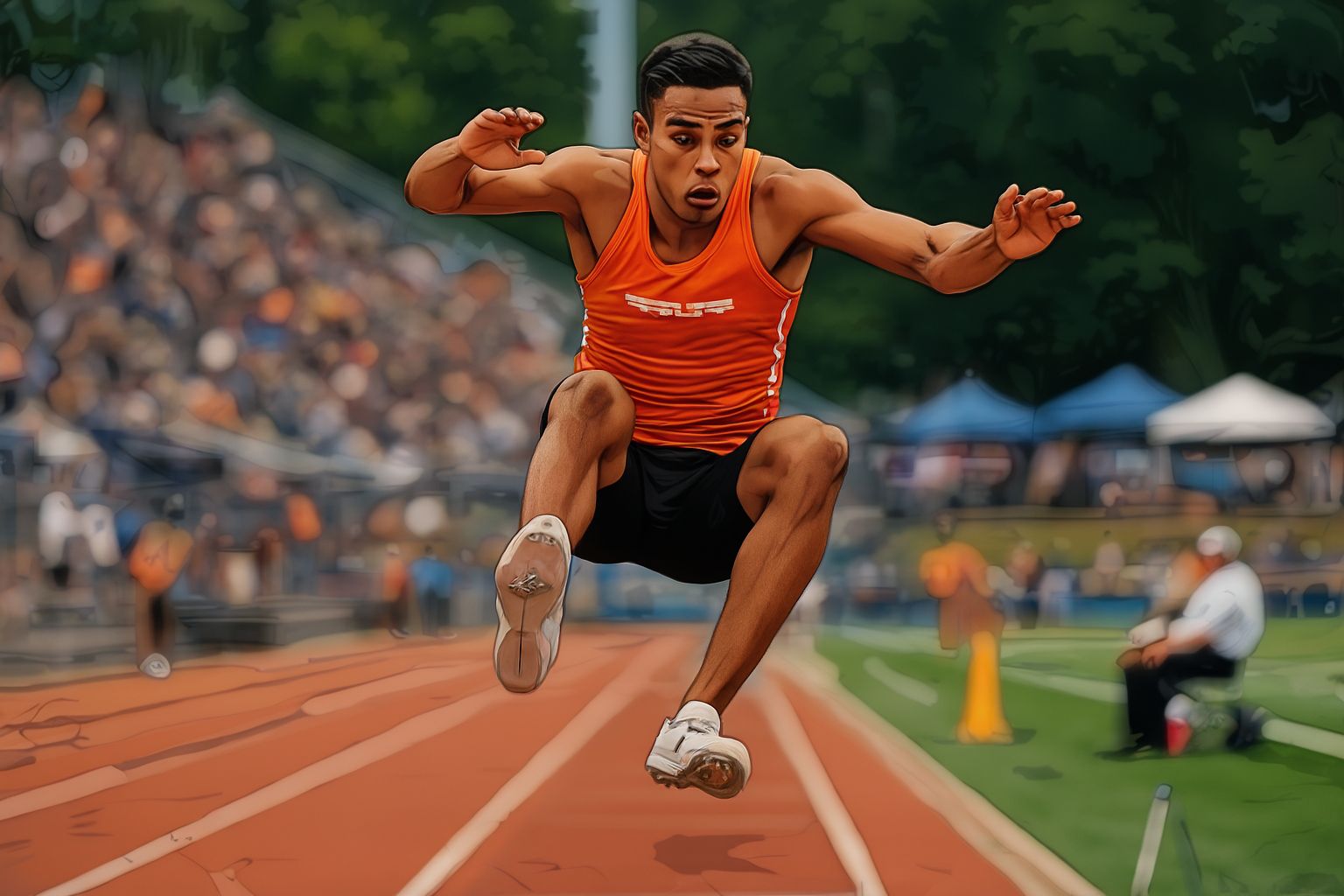The Path to Power and Precision: Jumping Events in Track and Field
Jumping events in track and field—whether it’s the explosive high jump, the graceful long jump, or the thrilling triple jump—are a witness to athleticism, precision, and power. These events demand a special combination of strength, agility, flexibility, and mental focus. If you’re an athlete aiming to excel in these sports, it’s essential to approach training with the same level of dynamism and precision as the event itself.
In this article, we’ll explore the best sports-specific training methods that will help you soar higher, leap farther, and maximize your performance. We will look at the science behind each jumping event, the exercises that target key muscle groups, and the strategies that professional athletes use to reach their peak potential.
Understanding the Mechanics of Jumping Events
Before diving into the training methods, it’s crucial to understand what makes the jumping events so unique. Each jump—whether it’s the high jump, long jump, or triple jump—has distinct mechanics that require different forms of strength and technique.
The high jump is all about vertical power, where athletes must generate enough lift and body control to clear a bar set at high heights. Proper technique, including the use of the Fosbury Flop (or a similar technique) and the ability to stay relaxed while reaching the peak of the jump, is key to success.
The long jump requires athletes to explode horizontally, combining speed and power to leap as far as possible from the takeoff point. This event demands a fine-tuned combination of running speed, technique, and the ability to launch the body at just the right angle.
In the triple jump, athletes perform a sequence of three phases: the hop, step, and jump. Speed, coordination, and rhythmic timing are all critical factors in mastering this event. Each phase requires specific mechanics, and the athlete must maintain consistent acceleration throughout the jump.
Understanding these mechanics helps in designing training programs that target the specific muscles and skills required for each event.
Building Explosive Power
The foundation of success in all jumping events is explosive power. This is the ability to generate a large amount of force in a short period, which is essential for an effective takeoff. To enhance explosive power, athletes need to focus on plyometric exercises, which train the body to generate high amounts of force quickly.
Plyometric exercises like box jumps, depth jumps, and bounding are great ways to increase explosive power. These exercises mimic the movements required in jumping events and train the body to react quickly and powerfully. They also help improve the stretch-shortening cycle, which is the process where muscles lengthen and then rapidly contract to produce force.
Strengthening the Core and Lower Body
In jumping events, core strength is just as important as leg power. A strong core allows an athlete to maintain body control in the air and helps in the transition of force from the lower body to the upper body. Core training should focus on dynamic movements that challenge stability while enhancing power transfer.
Key exercises for strengthening the core include medicine ball slams, Russian twists, and planks. These movements not only target the abs but also the muscles around the spine, improving balance and body control.
The lower body, especially the quads, hamstrings, calves, and glutes, is the powerhouse behind every jump. To build strength in these muscles, exercises such as squats, lunges, and deadlifts should be incorporated into your routine. These exercises should be done with heavy weights to increase muscle mass and strength, which directly translates to more powerful jumps.
Improving Speed and Agility
In the long jump and triple jump, speed is crucial in generating the momentum needed for a successful takeoff. Improving running technique and acceleration can significantly enhance your jumping ability. Sprints and shuttle runs help develop explosive speed, while agility drills improve the ability to change direction quickly, which is particularly important for the triple jump.
Short-distance sprints of 10 to 20 meters are effective for developing top-end speed. Speed work should focus on both the acceleration phase and the top-speed phase. Additionally, incorporating resistance sprints using parachutes or sleds can help build strength and speed simultaneously.
Agility drills, such as ladder drills, cone drills, and zig-zag sprints, are excellent for refining the quick, sharp movements required in the long and triple jumps. These exercises help develop coordination, foot speed, and control—key elements that athletes need to transition from the runway to the takeoff phase.
Flexibility and Mobility Training
Flexibility and mobility are often overlooked in jumping event training but play a vital role in maximizing performance. In events like the high jump, flexibility allows athletes to clear higher heights by providing greater range of motion in the legs and hips. In the long and triple jumps, mobility in the hips and ankles helps athletes achieve the proper takeoff angle and landings.
Stretching should focus on the hip flexors, hamstrings, calves, and quadriceps. Incorporating dynamic stretches, such as leg swings and high knees, is beneficial for preparing the muscles before jumping sessions. Static stretches after workouts can also help in improving overall flexibility, which aids in better technique and injury prevention.
Additionally, foam rolling and other myofascial release techniques can help increase tissue mobility and reduce muscle tightness, allowing athletes to achieve better range of motion.
Sport-Specific Drills for Each Jumping Event
To master any jumping event, specific drills that mimic the mechanics of the jump are essential. Let’s look at drills tailored to each event:
High Jump Drills
Approach and Takeoff Drills: These drills focus on refining the sprint approach and the transition to takeoff. Short sprints followed by jump practice, such as jump-over-the-bar drills, help athletes perfect their form and technique.
Fosbury Flop Drills: Practicing the technique used to clear the bar is essential. These drills involve jumping over low bars, gradually increasing height as the athlete’s form improves.
Bounding: This drill helps improve both the strength and flexibility needed for a high jump. Bounding requires the athlete to focus on their stride and posture, making it a great exercise for generating lift.
Long Jump Drills
Takeoff Drills: The key to a great long jump is the takeoff. Drills that simulate the jump phase, like runway-to-jump practice and step-over drills, help refine the athlete’s body position at the point of takeoff.
Speed Drills: The long jump requires a high-speed run-up. Sprints and acceleration drills are essential to help the athlete maintain momentum leading up to the jump.
Landing Drills: Practicing controlled landings is crucial in the long jump, both for technique and safety. Sand pit drills with focus on landing posture help improve the final phase of the jump.
Triple Jump Drills
Hop-Step Jump Drills: The most important aspect of the triple jump is perfecting the rhythm and timing of each phase. Hop-step drills that break down the jump into segments help athletes master this technique.
Speed and Rhythm Training: Developing the right speed and maintaining rhythmic flow through the hop, step, and jump is essential. Drills such as flying sprints and bounding drills can help improve the timing between phases.
Plyometric Box Drills: These exercises focus on developing the power and explosive strength needed for each phase of the jump. Athletes should practice these with an emphasis on quick, efficient movements.
Mental Preparation for Jumping Events
While physical preparation is crucial, mental toughness can make the difference between a good and great performance. High-pressure events like the high jump, long jump, and triple jump require athletes to stay focused, calm, and confident, especially when facing a high bar or a long leap.
Visualization techniques, where athletes mentally rehearse their jumps and visualize success, can help enhance focus and confidence. Relaxation techniques, such as deep breathing and mindfulness, are also essential for controlling nerves and maintaining a calm, focused mindset during the event.
The Final Leap: Training for Success
The journey to success in the jumping events is not just about power or speed—it’s about precision, focus, and dedication. To become an elite jumper, you need a training regimen that’s specific to your event, that builds strength, flexibility, and mental resilience. It’s not just about lifting heavy weights or sprinting fast, but also about refining your technique, enhancing your reaction time, and mastering the rhythm of your jumps.
Remember, the road to greatness is paved with dedication, hard work, and the understanding that every jump is a step closer to reaching your full potential. So get out there, push your limits, and let every jump bring you closer to your goal. Your leap to success awaits.
Jumping to New Heights
Whether you’re a high school athlete just starting your journey or a seasoned competitor aiming for your next championship, your training must reflect your goals. Through a combination of explosive power, agility, strength, flexibility, and mental resilience, you can master the jumping events in track and field.
Believe in yourself and train with purpose—your potential is as limitless as the heights you can reach. Every jump you take is one step closer to greatness.




